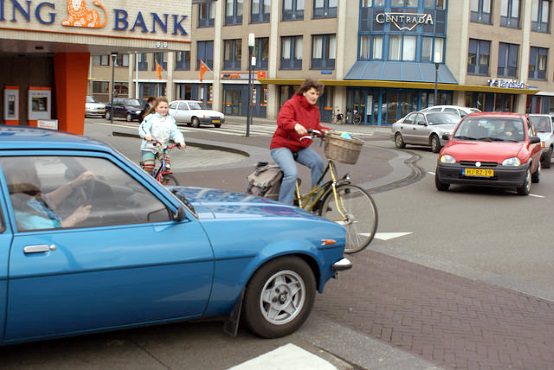Why Shared Space Scares

Can shared space work in the United States?
Surely not, was the response of many to my recent article describing the movement seeking to de-engineer and re-design our streets. For some reason this is the objection that immediately emerges everywhere the idea of shared space is raised: the British think ‘that may work for those upstanding Dutch, but not for us,’ Americans think ‘that may work for those nice Brits, but not us.’ Even in-country, you will often hear, ‘that may work in a small town, but not Jersey,’ ‘not Boston,’ ‘not where I’m from, have you seen these crazy people?’
I’m still sufficiently traumatized from my past experiences on Boston’s roads that I’ll bracket Beantown for the time being, but this is a very understandable, even desirable reaction. For shared space, the idea that pedestrians, bikes, cars all have equal claim to the street and should navigate the common space socially rather than hewing to the dictates of century-old traffic engineering, is intentionally scary.
Hans Monderman, the father of the shared space movement, made his name with the 2001 redesign of the Dutch town of Drachten’s town square. A town of 45,000, Monderman saw accidents fall from eight annually to one, yet was pleased to hear “that residents, despite the measurable increase in safety, perceived the place to be more dangerous. This was music to Monderman’s ears. If they had not felt less secure, he said, he ‘would have changed it immediately.'”
The rapidly growing English town of Ashford recently implemented a shared space design, so that “Without street signs, pavements, road markings or traffic lights, Ashford’s Elwick Square is confusing. Pedestrians cross from all angles, and some cars stop at the sides, while others make U-turns even though there is no roundabout.” The Financial Times reported, “In the three years before the scheme opened in November 2008, there were 17 accidents involving injury on this stretch of ring road. Since its creation, there have been just four.”
The FT also interviewed “Rebecca Skinner, a cleaner who crosses the road every day,” who said, “‘It looks nice, but I don’t feel safe at all. What makes drivers stop is making eye contact, but they might not be looking at you.'”
Ms. Skinner’s reaction is what every Monderman acolyte dreams of hearing. Under the influence of Prof. John Adams of University College, London, shared space designers recognize the influence of a “risk compensation effect,” whereby the comfort provided by a network of signs and lights relaxes the natural alertness one would carry into an environment shared with 2,000 pound steel machines. The discomfort induced by the alien shared space environment helps keep a pedestrian’s head on a swivel, and encourages active negotiation of the space, with eye contact and hand waving.
Now a few scattered projects are bringing shared space back to American shores. Chicago is implementing a near-shared space design on a four-block stretch in Uptown, with no sidewalks, stoplights, or crosswalks, and minimal signage, and FastCoExist notes that “shared streets exist in Seattle, Washington and Buffalo, New York.” It quotes Seattle Parks and Rec project manager Patrick Donoue as declaring, “Naysayers said, ‘People are going to get hit’ … Well, it just hasn’t happened.” Bombastic British car presenter Jeremy Clarkson declared about the Ashford scheme before it was built, “Someone is going to die, you idiots.”
Ben Hamilton-Baillie, Hans Monderman’s shared space heir, told me in an interview that he sees shared spaces working across the world, extending to Latin America, because the principles involved deal in human nature, not the particular hospitality customs of a few bike-happy Euro cultures. Such a claim can be overstated, but it is important to recognize that “shared spaces” were not a branded innovation but the almost unanimous state of the street across the world until the engineering interventions that accompanied the ascendancy of the car.
If we have been sharing spaces from the beginning of organized human settlements, then we may very well find latent hard-wiring ready to ease our transition in ways deeper and more complex than a traffic engineer could imagine. As Prof. John Adams says, “Road safety is not rocket science—it is much more complicated!”
This post was supported by a grant from the Richard H. Driehaus Foundation.
Comments